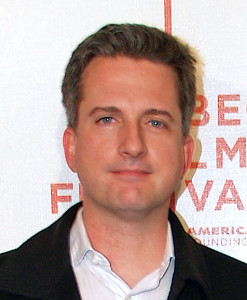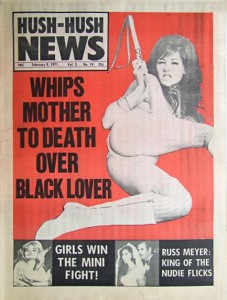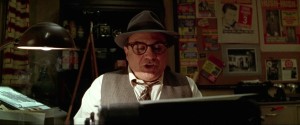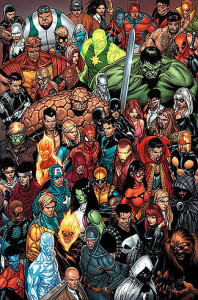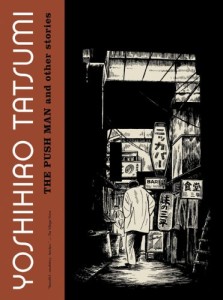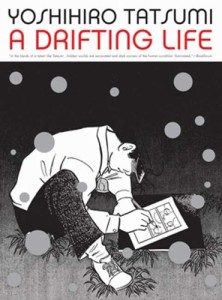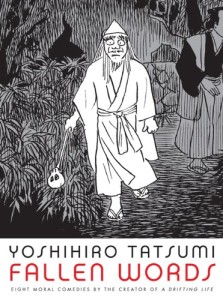This is prehistoric by Internet time, but a few months ago Paul Cantor’s essay “eBooks Are Great But….” left me thinking about a lot of issues surrounding the rise of digital books. I responded to him directly on Medium (you can read my full response), but as time passed one detail I touched on kept nagging me:
My biggest gripe with the Kindle is how it opens a new book to the first page of the first chapter. Here Amazon screwed up. Show me the cover, then let me page through the front matter to the first page. This is the pleasure and ritual of reading a new book.
Now every time I download a new ebook or sample, I think back to this comment. Amazon really did screw this up. When I pick up a physical book, the first thing I read is the cover, then the title page, then the rest of the front matter (“prelims” in the trade), before reaching the first page of the first chapter. This is not wasting my time. This is part and parcel of to the reading experience.
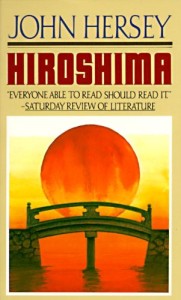 For the sake of example, let me take a physical book off my shelf—John Hersey’s Hiroshima.
For the sake of example, let me take a physical book off my shelf—John Hersey’s Hiroshima.
The cover for my paperback version is superb, a rising sun drenched in suggestive red. It rises over a moon bridge with the water below as blood-red as the sun. (Without a word printed on the cover I would immediately know this book regards Japan.) The quoted Saturday Review of Literature‘s exhortation that “everyone able to read should read it” is almost unnecessary at this point in time for a book of Hiroshima‘s stature, but I suppose it gives lingering on-the-fence customers one more reason to buy a copy.
Since I was a child I’ve studied book covers before diving in to the book itself. I’ve seen plenty of crappy book covers in my lifetime, but a great cover is worth moments of reflection. I’ve always admired the illustrator who can capture the essence of an entire book in a single image. Wendell Minor (the cover illustrator for this edition) did a fine job of that without exploiting the more obvious emotional signals the name Hiroshima evokes. The cover is tasteful, evocative, mournful, and thoughtful—just like the book itself.
Opening the book, the first printed page (titled “When the Bomb Dropped”) lists the main characters of Hiroshima along with brief biographies for each. This isn’t filler. This page suggests to me that Hiroshima is a book of many people, not just one. What’s more, this is not a book of dry facts about the detonation of the first atomic bomb against a population, nor is it scientific analysis. It’s also not a military history, as none of the names have a government or military title.
The next page lists John Hersey’s other books, published between 1943 to 1987. I was under the impression that Hersey was a journalist who fortuitously had a magazine feature article turned into a bestselling (and now historical) book. I didn’t know he had such a prolific career. While this seems minor, skimming down the list shaped how I received Hiroshima.
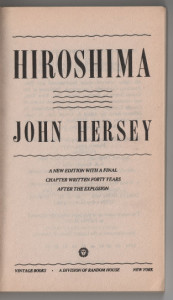 Then comes the title page, a clean, almost retro layout befitting the book’s original publication in the 1940s. A small note indicates the final chapter was written more recently, forty years after the bombing of Hiroshima. Again, that’s a nice piece of information to have—that while I’m reading a history book originally published contemporaneously with the events it describes, it’s not been frozen in time.
Then comes the title page, a clean, almost retro layout befitting the book’s original publication in the 1940s. A small note indicates the final chapter was written more recently, forty years after the bombing of Hiroshima. Again, that’s a nice piece of information to have—that while I’m reading a history book originally published contemporaneously with the events it describes, it’s not been frozen in time.
The colophon or copyright page may be the driest page of all front matter, but again, I glean something from it: “Copyright 1946, 1985 John Hersey.” Not everyone who picks up Hiroshima will recognize Hersey wrote it in the immediate aftermath of the bombing; that’s worth knowing before reaching the first page. Another tidbit to be learned: “The entire contents of this book originally appeared in The New Yorker,” additional historical context.
Then a modest table of contents. Five chapters numbered, each with a brief summarizing phrase that, even before reading the rest of the book, acts as a primer on the history Hersey records: “A noiseless flash.” “The fire.” “Details are being investigated.”
Only upon turning the table of contents does the first page of the first chapter arrive. If I’d downloaded Hiroshima to my Amazon Kindle, this would be the first page presented. I would have been robbed—look again at the experience I’ve accumulated perusing the book’s cover and front matter.
I’m not blasting ebooks or declaring them dead or a horrible experience. I’m suggesting Amazon has made a questionable design decision, and one easily corrected. A simple option in the Settings would be enough to satisfy me.
Update: More on Hiroshima, John Hersey, and book covers here.
